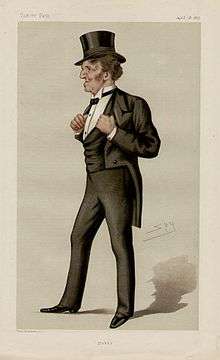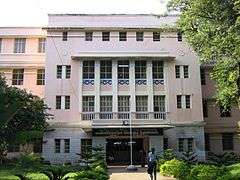Robert Bourke, 1st Baron Connemara
Robert Bourke, 1st Baron Connemara, GCIE, PC (11 June 1827 – 3 September 1902) was a British Conservative politician and colonial administrator. He served as Under-Secretary of State for Foreign Affairs between 1874 and 1880 and 1885 and 1886, and was Governor of Madras between 1886 and 1890.
The Lord Connemara GCIE PC | |
|---|---|
 "Bobby". Caricature by Spy published in Vanity Fair in 1877. | |
| Governor of Madras Presidency | |
| In office 8 December 1886 – 1 December 1890 | |
| Monarch | Victoria |
| Preceded by | M. E. Grant Duff |
| Succeeded by | John Henry Garstin |
| Under-Secretary of State for Foreign Affairs | |
| In office 23 February 1874 – 21 April 1880 | |
| Monarch | Victoria |
| Prime Minister | Benjamin Disraeli |
| Preceded by | Viscount Enfield |
| Succeeded by | Sir Charles Dilke |
| In office 25 June 1885 – 28 January 1886 | |
| Monarch | Victoria |
| Prime Minister | The Marquess of Salisbury |
| Preceded by | Lord Edmond Fitzmaurice |
| Succeeded by | James Bryce |
| Personal details | |
| Born | 11 June 1827 Hayes, County Meath |
| Died | 3 September 1902 (aged 75) London, England |
| Nationality | Irish |
| Political party | Conservative |
| Spouse(s) |
|
| Alma mater | Trinity College, Dublin |
Background and education
Bourke was born into an Anglo-Irish aristocratic family at Hayes, County Meath,[1] Ireland, the third son of Robert Bourke, 5th Earl of Mayo, and Anne Charlotte, daughter of The Hon. John Jocelyn. His older brother was The 6th Earl of Mayo, a Viceroy of India. He was educated at Hall Place School, Bexley, Kent, and Trinity College, Dublin, and was called to the Bar, Inner Temple, in 1852.[2]
Political career
Bourke practised as a barrister for a number of years before being elected Conservative Member of Parliament for King's Lynn in 1868.[2][3][4] In 1874 he became Under-Secretary of State for Foreign Affairs in Benjamin Disraeli's second administration, a post he held until 1880,[2] when he was also sworn of the Privy Council.[5] He held the same post from 1885 to 1886 in Lord Salisbury's first administration.[2]
Governor of Madras

In 1886, Bourke was appointed Governor of Madras.[6] The following year he was appointed a Knight Grand Commander of the Order of the Indian Empire[2] and raised to the peerage as Baron Connemara, of Connemara in the County of Galway.[7] In 1890 he laid the foundations stone of the Connemara Public Library in Madras, which was named after him and opened six years later.[8] The building was originally planned to house the proposed Victoria Technical Institute which was constructed in 1887, the Golden Jubilee year of Queen Victoria's reign. The third session of the Indian National Congress was held at Madras in 1887 when Lord Connemara was the governor. He hosted a garden party at Government House for the delegates. The construction of the Madras High Court was commenced in 1889.
Lord Connemara is credited with introducing a number of reforms while serving as governor. He personally supervised the famine-relief measures at Ganjam and reorganised the sanitary administration of Madras city. He also improved and extended the east coast railway line connecting Madras with Calcutta. The Madras Mail, in its 4 December 1890 issue, comments that his administration was "a bright epoch in the annals of Madras". He resigned as governor on 8 November 1890 and returned to Great Britain.
Later life
Lord Connemara contributed occasionally in the House of Lords, mostly on matters dealing with foreign affairs, making his last speech in June 1898.[9] He also published the work Parliamentary Precedents.[1]
Family
Lord Connemara was twice married. He married firstly Lady Susan Georgiana, daughter of The 1st Marquess of Dalhousie, a former Governor-General of India, in 1863. They divorced in 1890. In 1894, he married Gertrude, former wife of Edward Coleman. Both marriages were childless. His second wife died in November 1898. Lord Connemara died in London in September 1902, aged 75,[2] and was buried in the city's Kensal Green Cemetery.[10] His barony became extinct at his death.
References
- The New York Times 4 September 1902: "Lord Connemara Dead".
- thepeerage.com Robert Bourke, 1st and last Baron Connemara
- "No. 23443". The London Gazette. 20 November 1868. p. 6000.
- leighrayment.com House of Commons: Kilkenny County to Knutsford
- "No. 24837". The London Gazette. 23 April 1880. p. 2652.
- "No. 25620". The London Gazette. 27 August 1886. p. 4176.
- "No. 25700". The London Gazette. 13 May 1887. p. 2641.
- connemarapubliclibrarychennai.com History
- Hansard Mr Robert Bourke
- kensalgreencemetery.com Archived 13 July 2011 at the Wayback Machine
External links
- Hansard 1803–2005: contributions in Parliament by Lord Connemara
| Parliament of the United Kingdom | ||
|---|---|---|
| Preceded by Sir Thomas Buxton Lord Stanley |
Member of Parliament for King's Lynn 1868–1886 With: Lord Stanley 1868–1869 Lord Claud Hamilton 1869–1880 Sir William ffolkes 1880–1885 (representation reduced to one member 1885) |
Succeeded by Weston Jarvis |
| Political offices | ||
| Preceded by Viscount Enfield |
Under-Secretary of State for Foreign Affairs 1874–1880 |
Succeeded by Sir Charles Dilke |
| Preceded by Lord Edmond Fitzmaurice |
Under-Secretary of State for Foreign Affairs 1885–1886 |
Succeeded by James Bryce |
| Government offices | ||
| Preceded by M. E. Grant Duff |
Governor of Madras 1886–1890 |
Succeeded by John Henry Garstin |
| Peerage of the United Kingdom | ||
| New creation | Baron Connemara 1887–1902 |
Extinct |